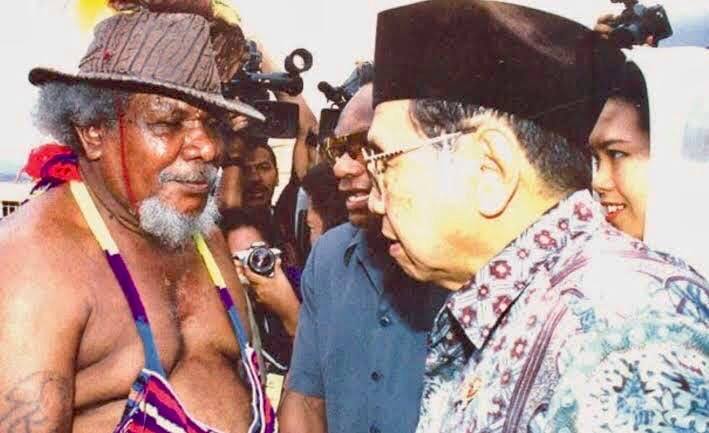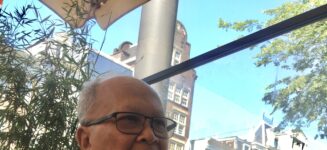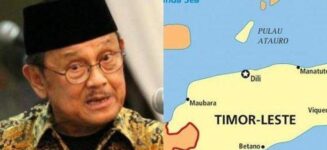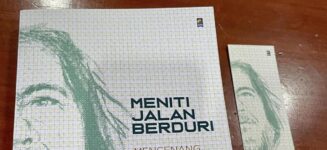The article has been published in the Jakarta Post & Pacific Islands Report & Kabar Irian
http://www.pireport.org/articles/2000/12/25/gus-dur-ends-his-honeymoon-papua?fbclid=IwAR0QwvWPiztJQmgNLpf-CWE1krR78WnaIkfQNPf4BeqjHLpjKkyO1Q6TvAo
JAYAPURA, Irian Jaya (December 21, 2000 – The Jakarta Post/Kabar-Irian)
It was a milestone when President Abdurrahman Wahid chose to welcome the year 2000 in Irian Jaya, greeted the sunset by restoring the name to “Papua” and allowed the Morning Star flag to be flown, said the Irianese. For the first time, they felt Indonesia appreciated them rather than being merely interested in natural resources and security.
Yet one year on, the New Order’s security approach has been revived, abruptly terminating the honeymoon. The Irian Jaya issue, like Aceh’s, may turn out to be a crucial test for democratic reform in Indonesia, rather than becoming part of it.
A momentum of rising hope among the Irianese, heightened tension and stern action from the security administration marked the 39th anniversary of Irian Jaya’s declaration of independence this year, which possibly ended up in a purge of pro-independent leaders.
“I witnessed the events of December 1, 1961 in this very place,” an old man on the corner of Jalan Martin Indey proudly said. “Now many people want independence, much more than in the past.” He then cried and wished me good luck.
A few hours later, in the early morning of December 1, 2000, the Morning Star flag was hoisted for the last time at Imbi Square in the same spot as almost four decades ago: the front of the former Nieuw Guinea Raad, now the Irian Jaya Art and Cultural Council, DKIJ building. In Jayapura, or Port Numbay as locals call it, both young and old are aware that their homeland was declared independent on December 1, 1961, although, they said, “the truth had subsequently been diverted.”
Almost four decades later, public expectation was so high that many believed the independence and sovereignty of Irian Jaya would be restored on the anniversary. Yet none of the leaders promised to do so. So who was responsible for this public mood?
Curiously, the local authorities made systematic attempts to reduce the meaning of December 1, harass the populace and halt the pro-independence movement.Irianese key leaders Theys Hiyo Eluay and Thaha al Hamid were arrested shortly before the rally. No politics was allowed at the rally, the commemoration was reduced to a Ibadah Syukuran (thanksgiving prayer) and its program was curtailed to “folk entertainment” as a result of heavy pressure through the November 9 agreement between the authorities and the pro-independent Papua Presidium Council.
For the first time since reformation began in 1998, Jakarta imposed a ban on political statements at a public meeting. This has not occurred even in restive Aceh. A show of force on the eve of December 1 later changed Jayapura’s city center into a military occupation zone.”The New Order’s security approach has been revived,” one observer said.
As the media were gone, two days later, the security administrations went into action — a pattern that reminds one of East Timor shortly before last year’s mayhem began. The Irian Jaya Art and Cultural Center building, which served as the headquarters of the pro-independence militia, was seized and several Papuan task force members and activists, including some civil servants, were detained and warned.Later, a dozen key leaders and a Swiss journalist were harassed or arrested.
Elsewhere in the more restive towns of Fakfak, Manokwari and Merauke, a dozen people were killed as flag incidents erupted.Yet the people remained generally restrained, expressing their aspirations in politico-religious terms. They said they had a natural right to be independent, that their leaders had achieved it on December 1, 1961 and that “other people have taken over our homeland since then.” They were referring to Indonesia, which has ruled Irian Jaya since May 1, 1963.
The present nationalism is viewed by Irianese as sacred, divinely inspired and natural — quite the opposite as to how Indonesian nationalism is perceived. “My dear brothers and sisters,” said Irianese leader Tom Beanal at the December 1 rally, “congratulations on the anniversary of the independence of the Papuan nation, and let us at the same time commemorate the humiliation of our nation.
“We are being totally constrained and curtailed (but) let us remind ourselves that our leader in this struggle is God Almighty. If God is our leader, what are we afraid of? (If) God is great in your heart, He will bring us to the truth so that everybody will ultimately realize his rights.”God’s leadership is now part of the people’s discourse to express their aspirations and talk about their struggle for independence.
At one point, a priest at the rally yelled: “December 1 was the day Jesus Christ was born, not December 25!”With God taking the lead for the Irianese as Tom Beanal had suggested, the other side of the game — the Indonesian security administration — was by implication perceived as “the great devil.
“A similar discourse in the past could be depicted in the imagery of East Timor facing Indonesia as David and Goliath or Indonesia fighting the Dutch in the 1940s as the good guys versus the bad guys. At a seminar near Jayapura, a young student proposed an outright denial of imagery. “Ladies and gentlemen, a nation and state are two different things,” he said. “The state is a creation of men, but a nation, the Papuan nation, is God’s precious gift. So how can the Papuan nation become the Indonesian nation?”
Interestingly, the question did not shock the public, but created deep silence. A few were confused, but most seemed to agree. The fact that the new Irianese nationalism is seen as sacred, divinely inspired and natural means that it is being projected as the very anathema to how Indonesian nationalism is perceived.
Although Irian Jaya — a colorful tribal civilization of almost two million, with 240 tribes and dozens of languages — may be as diverse as the Indonesian archipelago, Irianese self-consciousness seems clear cut and geographically well defined. Indonesia, by contrast, is a great political concept born in the 1920s, covering various ethnic and language groups, yet it is seen as an expansionist. The latter refers to the takeover of Irian Jaya (1963) and artificial expansion of Indonesian nationalism to the brutally annexed East Timor (1976).
The three decades of the New Order regime, more than anything else, left fundamental imprints on both the conditions in Irian Jaya and the perceptions of its people. It created a new Irianese nationalism, which only came fully into the open when Suharto’s Pandora’s box was opened in 1998.
The Irianese were conscious of their differences with Indonesians. “So first, an ethnic-nationalism arose, then came the attempt to unite and fight the injustice, lies and inequality. Ultimately, it’s been an attempt to achieve independence,” Frits Agapa, a non-governmental organization (NGO) volunteer said.
Anthropologist Benny Giay essentially agreed. Irianese nationalism, he said, consists of three elements that run against Indonesia’s mainstream assumptions.First, a strong awareness of being (West) Melanesian; second, a protest against the New Order’s economic exploitation and military violence; and, third, a general awareness that Irianese rights have been manipulated by the outside world, that is Indonesia, the Netherlands, the United States and the United Nations, through the New York Agreement of 1962 and the Act of Free Choice of 1969.
The third element is now popularly referred to as restoring the truth and reflected by the council’s program of rectifying history.Irian Jaya has seen a long series of isolated local uprisings since 1965.
There have also been many examples of Irianese nationalism in the past, but as Indonesian scholar George Aditjondro pointed out, it was not until Thomas Wanggai proclaimed Irian Jaya as a Melanesian state in 1988, that a broad ethnic consciousness was clearly expressed.Under the leadership of the democratically elected Papua Presidium Council, for the first time a national movement has come into being that encompasses the whole province and social strata.
“The Presidium has been very successful in promoting the concept of independence down to the villagers,” said Australian scholar Richard Chauvel in Jayapura. Serui, once a strong base of pro-Indonesian Irianese, has turned pro-independent as has the Evangelical Church Council and the Amber (non-Irianese migrant) communities in the northern urban centers, as several examples.
To understand Irian Jaya, it should be noted that, first, the province has been colonized 18 years longer than other parts of Indonesia since it was incorporated into the Republic in 1963. Crucially, that period was the most decisive in terms of creating a national solidarity as the young nation-state was fighting for its survival and then consolidated when the center was threatened by the rebellions of the 1950s.The Irianese did not take part in Indonesia’s nation-building processes. Neither were they represented in earlier historic events, such as the Youth Oath of 1928.
As a result, with the New Order’s brutal adventures in Irian Jaya, Indonesia is being perceived as the “great devil” rather than as one big family. Second, late president Sukarno’s nation-building politics was based on the experiences of Indonesia’s western regions (from Bali and Sulawesi to the west) with Dutch colonialism, rather than being balanced by the experiences of eastern regions, especially in Irian Jaya.
Colonialism meant for the Irianese that their rich homeland was being plundered for the sake of others, be they Dutch or Indonesian. Yet they had not seen the Dutch war crimes as people in Java or South Sulawesi had witnessed. With the New Order and military operations, for the first time the Irianese experienced the kind of colonialism that, in addition to economic exploitation, adat (traditional) land confiscation, social and racial discrimination, also involved brutal repression and massacre.
This, as Benny Giay said, was made ironically clear when the Irianese greeted the Dutch parliamentary delegation early this year. One person yelled out in Dutch: “Dutchmen, you are truly formidable teachers because you have taught Indonesia to be a better colonizer.”
That may not be truly fair, but it does pointedly, if implicitly, express the Irianese concept of Indonesian colonialism as one which was marked not just by economic exploitation, but by mass violence as well. Irian Jaya’s death toll under the New Order is much less clear than the numbers for East Timor or Aceh, but even the most conservative figures released by reliable human rights sources vary between 300 to 500,000.
The New Order adventure had strengthened a new Irianese nationalism, with Irianese now starting to develop a process of self-determination. Therefore, the President was instinctively correct when he started Jakarta’s reconciliation by restoring the name Papua and allowing the Morning Star flag to fly.
The Irianese watch carefully what others do with their symbols. As was the case with Indonesia’s flag in the 1940s (the Oranje Hotel incident, Surabaya, 1945), once the Morning Star flag marked historical events and was seen as a common identity, it inevitably became a key political symbol, no matter how others define it.”It’s definitely the symbol of our inalienable rights,” Willy Mandowen, the council mediator, said.
Yet given the nature of New Order rule in Irian Jaya, the President’s gesture might have been too late even before it was proposed. Now with even that being blocked by his ultranationalist and military opponents in Jakarta, the prospect could take a dangerous turn. For Jakarta cannot pretend to promote democratization and at the same time revive the New Order’s heavy-handed approach in the regions.
The path for an honest dialog with the regions should remain open since the alternative of a growing secessionist trend could invite antidemocratic forces to reestablish a strong rule, a new New Order, in the center. The events of December in Irian Jaya, therefore, raise the question whether the integrity of the Republic can be maintained with an iron fist, while at the same time claiming democratic reform. Or will the state choose the first at the expense of the latter?
Unless the issues of Irian Jaya and Aceh are integrated into a reform program and are resolved democratically, sooner or later Jakarta has to face that painful dilemma. The Irianese also face enormous and complex challenges.
The Papua Presidium Council, born out of the democratic process of the Second Papua People’s Congress last May, has proposed to pursue an open and peaceful policy of “dialog, love and courtesy.”Efforts have been made to make peaceful zones in Serui and Timika, and win credit throughout the province. Even the guerrilla movement — one which has a longer history, but is small and suffering from endemic factionalism — the National Liberation Army of the Free Papua Movement (OPM-TPN), agreed in Vanuatu in July to recognize the authority of the council. The council is the biggest, most peaceful and moderate pro-independent movement in Irian Jaya.
Tom Beanal, its soft-speaking, amicable vice chairman, who is a highland tribe leader, is loved by the Irianese and is respected elsewhere. In 1996 he was a nominee for the prestigious Yap Thiam Hien Human Rights Award in Jakarta. Yet the council lacks worldwide support and faces pressure from radical groups, such as the Papua National Forum (FNP) of former political prisoners, also known as the Kalisosok group, and the Penis Gourd Council of Elders (DMK), who want to accelerate unilateral secessionism.
The end of the Abdurrahman-Irian Jaya dialog, therefore, may unnecessarily isolate the council and lead to a more dangerous political situation. Above all, the main challenges basically come from the urgent need to build stronger human resources and institutions to lay down a solid base for the future in order to prevent conflict among tribes, between urban groups and highlanders and between them and non-Irianese migrants.
The Wamena and Merauke incidents, on October 10 and November 3 respectively, illustrate the fragile nature of these interrelationships and the strong potential for Irian Jaya to become a conflict area that could be even more dangerous than Maluku or East Timor.
John Rumbiak, a human rights activist in Jayapura, therefore, argues for a long-term program of development and reconciliation. “A country that is liberated by violence, will only sow seeds of cruelty which will be difficult to abolish, but a people who liberate their nation by peace will invest in a new future that will guarantee their rights.”
The Irianese will probably have a long and possibly painful journey. Just as Jakarta’s pendulum has swung from honeymoon to repression, many Irianese have moved to take what Nelson Mandela, reflecting on his struggle, calls “a long walk to freedom.
“The writer is a journalist. This article was written early this month in Irian Jaya.



